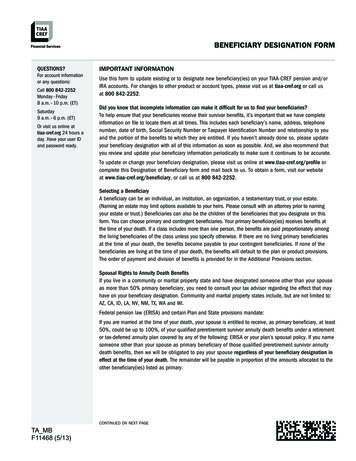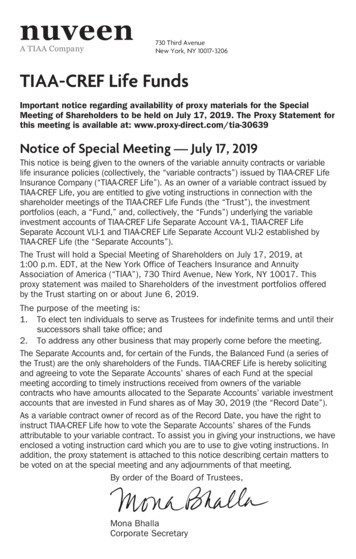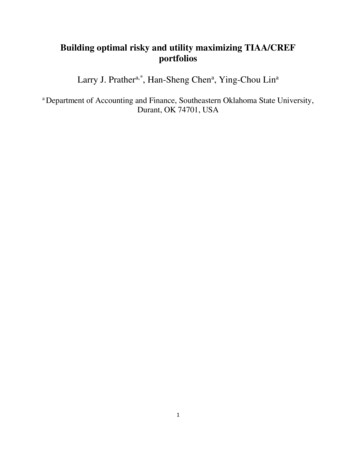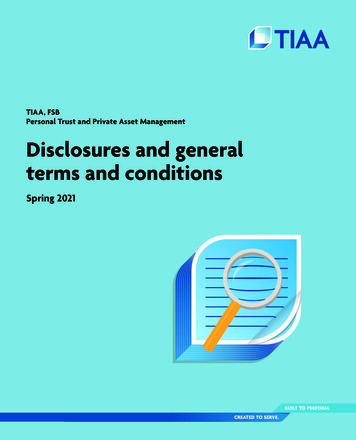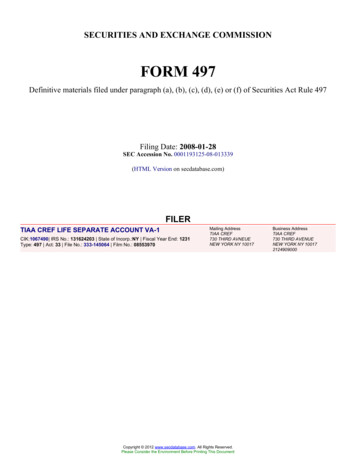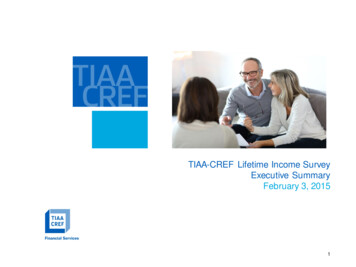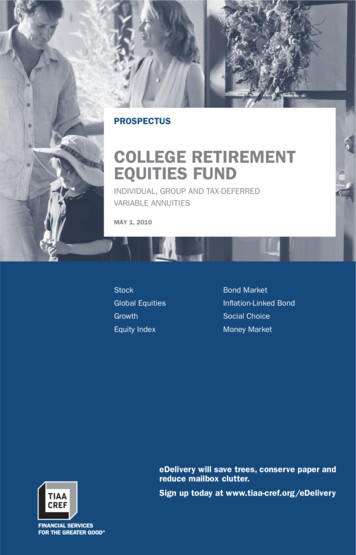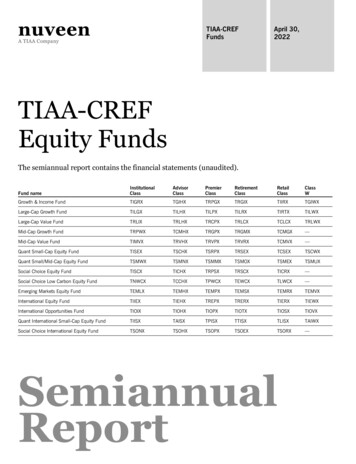
Transcription
TIAA-CREFFundsApril 30,2022TIAA-CREFEquity FundsThe semiannual report contains the financial statements (unaudited).Fund rementClassRetailClassClassWGrowth & Income FundTIGRXTGIHXTRPGXTRGIXTIIRXTGIWXLarge-Cap Growth FundTILGXTILHXTILPXTILRXTIRTXTILWXLarge-Cap Value FundTRLIXTRLHXTRCPXTRLCXTCLCXTRLWXMid-Cap Growth FundTRPWXTCMHXTRGPXTRGMXTCMGX—Mid-Cap Value FundTIMVXTRVHXTRVPXTRVRXTCMVX—Quant Small-Cap Equity FundTISEXTSCHXTSRPXTRSEXTCSEXTSCWXQuant Small/Mid-Cap Equity FundTSMWXTSMNXTSMMXTSMOXTSMEXTSMUXSocial Choice Equity FundTISCXTICHXTRPSXTRSCXTICRX—Social Choice Low Carbon Equity FundTNWCXTCCHXTPWCXTEWCXTLWCX—Emerging Markets Equity FundTEMLXTEMHXTEMPXTEMSXTEMRXTEMVXInternational Equity FundTIIEXTIEHXTREPXTRERXTIERXTIEWXInternational Opportunities FundTIOIXTIOHXTIOPXTIOTXTIOSXTIOVXQuant International Small-Cap Equity FundTIISXTAISXTPISXTTISXTLISXTAIWXSocial Choice International Equity FundTSONXTSOHXTSOPXTSOEXTSORX—SemiannualReport
As permitted by regulations adopted by the Securities and Exchange Commission, paper copies of the TIAA-CREF Funds’ (the “Funds”)annual and semiannual shareholder reports will not be sent to you by mail, unless you specifically request paper copies of the reports.Instead, they will be made available on TIAA’s website, TIAA.org, and you will be notified by mail each time a report is posted and providedwith a website link to access the report.You may elect to receive shareholder reports and other communications from the Funds electronically anytime by either (1) updating youraccount settings at TIAA.org/eDelivery, if you invest in the Funds directly or hold your Fund shares through a TIAA-affiliated financialintermediary, account or retirement plan (each, a “TIAA Account”), or (2) contacting your financial intermediary (such as a broker/dealer orbank) through which you hold Fund shares.If you invest directly with the Funds or through a TIAA Account, you may elect to receive all future shareholder reports in paper free ofcharge by updating your account settings at TIAA.org/eDelivery or by calling 800-842-2252 during regular business hours. If you investthrough another financial intermediary, you can contact your financial intermediary to request that you receive paper copies of yourshareholder reports. Your election to receive reports in paper will apply to all funds held with the fund complex if you invest directly with theFunds or through a TIAA Account, or to all funds held through your financial intermediary.ContentsUnderstanding this reportLetter to investorsMarket monitorInformation for investorsAbout the funds’ benchmarksImportant information about expensesFund performanceGrowth & Income FundLarge-Cap Growth FundLarge-Cap Value FundMid-Cap Growth FundMid-Cap Value FundQuant Small-Cap Equity FundQuant Small/Mid-Cap Equity FundSocial Choice Equity FundSocial Choice Low Carbon Equity FundEmerging Markets Equity FundInternational Equity FundInternational Opportunities FundQuant International Small-Cap Equity FundSocial Choice International Equity FundSummary portfolios of investmentsFinancial statements (unaudited)Statements of assets and liabilitiesStatements of operationsStatements of changes in net assetsFinancial highlightsNotes to financial statements2021 special meetingApproval of investment management agreementLiquidity risk management programAdditional information about index providersHow to reach 24125132133Inside back cover
Understanding this reportFor the purposes of this report, “TIAA-CREF Funds” refersonly to the TIAA-CREF Equity Funds listed on the cover ofthis report.This semiannual report contains information aboutcertain TIAA-CREF Funds and describes their results for thesix months ended April 30, 2022. The report contains fourmain sections: A letter from Brad Finkle, Principal Executive Officer andPresident of the TIAA-CREF Funds and TIAA-CREF LifeFunds. The fund performance section compares each fund’sinvestment returns with those of its benchmark index. The summary portfolios of investments list the industriesand types of securities in which each fund hadinvestments as of April 30, 2022. The financial statements provide detailed informationabout the operations and financial condition of each fund.The views and opinions expressed in this report arethrough the end of the period, as stated on the cover of thisreport. They are subject to change at any time based on avariety of factors. As such, they are not guarantees of futureperformance or investment results and should not be takenas investment advice. To see the risks of investing in anyfund, please read the latest prospectus.As always, you should carefully consider the investmentobjectives, risks, charges and expenses of any fund beforeinvesting. For a prospectus that contains this and otherimportant information, please visit our websites at TIAA.org ornuveen.com, or call 800-842-2252 for the Institutional,Advisor, Premier and Retirement classes or 800-223-1200for the Retail Class. We urge you to read the prospectuscarefully before investing.TIAA-CREF Funds: Equity Funds 2022 Semiannual Report3
Letter to investorsGlobal stocks lost ground for the six months ended April 30, 2022. As inflationclimbed higher during the period, the Federal Reserve responded by tighteningmonetary policy, raising short-term interest rates and indicating that furtherincreases were likely. However, some international economies continued to grow,despite rising prices and the impact of Russia’s invasion of Ukraine. For thesix months: Brad Finkle The Russell 3000 Index, which measures the performance of the broad U.S.stock market, returned –11.8%. Please see page 8 for benchmark definitions.The MSCI EAFE Index, which represents stocks in 21 developed-markets nationsoutside North America, also returned –11.8%.The MSCI Emerging Markets Index, which tracks the performance of stocks in 24developing nations, returned –14.2%.All 14 of the TIAA-CREF Equity Funds produced negative returns. Four of the fundsoutperformed their respective benchmarks for the period.U.S. economic growth was mixedDomestic stocks recorded losses for the six months as inflation and rising interestrates weighed on financial markets. The U.S. economy expanded in the fourthquarter of 2021 but contracted in the first quarter of 2022. A widening trade gapand lower government spending contributed to the slowdown, but spending byconsumers and businesses remained strong. Unemployment fell to ratesapproaching pre-pandemic lows. In addition to raising short-term interest rates, theFed indicated that it intends to reduce its portfolio of bonds that had beenpurchased to support the economy.For the six months, small-cap equities trailed large- and mid-sized stocks, whilegrowth shares underperformed value stocks. (Returns by investment style andcapitalization size are based on the Russell indexes.)Foreign developed markets posted lossesForeign developed-markets stocks declined despite sustained economic growth inmany countries. The economies in the 19-nation euro area grew at a moderate ratein the fourth quarter of 2021 and the first quarter of 2022. The United Kingdom’seconomy grew at a similar pace through February 2022. Among developing markets,the Chinese economy continued to expand at a solid pace through the first quarterof 2022. The European Central Bank left its benchmark rates unchanged but said itmay end its bond-buying program in the third quarter of 2022. The Bank of Englandraised its benchmark interest rate to 0.75%.Emerging markets trailed U.S. and foreign developed equitiesEmerging-markets stocks posted losses for the period. Thirteen of the 24 countriestracked by the MSCI Emerging Markets Index recorded gains in U.S. dollar-terms.But China, which accounted for more than 30.0% of the index’s weighting at periodend, posted a larger decline than the index. Taiwan, India and South Korea, whichrepresented more than 40.0% of the index’s weighting collectively, each registeredlosses as well.42022 Semiannual Report TIAA-CREF Funds: Equity Funds
Four funds outpaced their benchmarksAll of the 14 TIAA-CREF funds produced negative returns,though four outperformed their respective benchmarks.Performance ranged from a return of –3.6% by the Mid-CapValue Fund to a return of –28.7% by the Mid-Cap GrowthFund.Fund performances generally reflected market trendsfavoring larger-cap and value-oriented stocks. The Mid-CapValue Fund’s return outpaced the Russell Midcap ValueIndex. The Large-Cap Value Fund returned –5.4%, trailing theRussell 1000 Value Index.The Quant Small/Mid-Cap Equity Fund returned –11.3%and outpaced the Russell 2500 Index, while the QuantSmall-Cap Equity Fund outperformed its benchmark, theRussell 2000 Index, with a return of –14.1%.The Social Choice Equity Fund returned –12.3%, and theSocial Choice Low Carbon Equity Fund returned –12.9%.Both funds trailed their shared benchmark, the Russell3000 Index.The Growth & Income Fund returned –13.0%, lagging itsbenchmark, the S&P 500 Index. The Large-Cap GrowthFund returned –23.3% and trailed the Russell 1000 GrowthIndex. The Mid-Cap Growth Fund also lagged its benchmark,the Russell Midcap Growth Index.Among foreign funds, the Social Choice InternationalEquity Fund returned –12.1%, and the International EquityFund returned –16.8%. Both funds trailed their sharedbenchmark, the MSCI EAFE Index.The Quant International Small-Cap Equity Fund returned 12.7%, outperforming the MSCI All Country World (ACWI)ex USA Small Cap Index.The Emerging Markets Equity Fund returned –15.4% andlagged its benchmark, the MSCI Emerging Markets Index.The International Opportunities Fund returned –21.7%,trailing the MSCI All Country World (ACWI) ex USA Index.A detailed overview of the financial markets during thesix-month period appears on page 6, and a discussion ofhow each fund performed in relation to its benchmarkbegins on page 10.Keeping a focus on long-term goalsInvestors may have been understandably concerned aboutthe volatility in financial markets during the first four monthsof 2022. After well over a decade of generally favorableconditions, markets now face new challenges in the form ofrising inflation and its implications for higher interest rates.But periods of volatility and economic uncertainty are notnew, and history has shown that timing the market is nearlyimpossible. However, we believe that no matter what theeconomic outlook may be, maintaining a diversified portfoliothat includes stocks, bonds and other asset classes as partof a long-term, well-thought-out financial plan is a wisecourse of action. A professionally managed portfolio ofmultiple asset classes can help investors achieve theappropriate balance of risk and reward to reach their longterm investment objectives. Of course, diversificationcannot guarantee against market losses.If you have any questions or would like to discuss thestatus of your portfolio, please do not hesitate to contactyour financial advisor or call a TIAA financial consultant at800-842-2252. We are here to help you.Brad FinklePrincipal Executive Officer and President of the TIAA-CREF Funds andTIAA-CREF Life FundsTIAA-CREF Funds: Equity Funds 2022 Semiannual Report5
Market monitorEquity markets declined across the boardFor the six months ended April 30, 2022, U.S. stocks lostground primarily due to concerns over the economic impactof rising inflation and higher interest rates. The Russell3000 Index, a broad measure of U.S. stock marketperformance, returned –11.8%. International developed- andemerging-markets equities also posted double-digit declines.U.S. economy produced mixed resultsThe U.S. economy grew at a robust pace early in the period.A strong labor market helped drive consumer spendingincreases, pushing the economy forward despite ongoingconcerns over COVID-19 variants and significant supplychain disruptions. Real gross domestic product (GDP), whichmeasures the value of all goods and services produced inthe United States, grew at an annualized rate of 6.9% in thefinal three months of 2021. However, GDP contracted by1.5% in the first quarter of 2022, according to thegovernment’s “second” estimate. A widening trade deficitand lower government spending contributed to the reversal,although consumer and business spending remained strong.The unemployment rate continued to decline during theperiod, falling from 4.2% in November 2021 to 3.6% in April2022. Core inflation, which includes all items except foodand energy, rose 6.2% over the twelve months ended inApril 2022. The price of oil climbed amid continuing strongdemand and supply concerns related to Russia’s invasion ofSmall-cap growth stocks posted biggest lossesU.S. large-cap value stocks performed best in a down .2%–17.8%-20-25–25.4%–26.8%-30U.S. large capgrowthU.S. mid capvalueU.S. small onalSource: U.S. large-cap growth: Russell 1000 Growth Index; U.S. large-cap value:Russell 1000 Value Index; U.S. mid-cap growth: Russell Midcap Growth Index; U.S.mid-cap value: Russell Midcap Value Index; U.S. small-cap growth: Russell 2000 Growth Index; U.S. small-cap value: Russell 2000 Value Index; Foreign developedmarkets: MSCI EAFE Index; Emerging markets: MSCI Emerging Markets Index. Sixmonth returns as of April 30, 2022.62022 Semiannual Report TIAA-CREF Funds: Equity FundsUkraine. The price of West Texas Intermediate (WTI) crudeoil rose from 84 per barrel on November 1, 2021, toalmost 105 per barrel on April 30, 2022. WTI oil pricespeaked at nearly 124 in March, reaching their highestlevel since 2008. Meanwhile, the U.S. dollar generallygained ground against other major currencies during thesix-month period.Small-cap stocks and growth shares declined mostAmong U.S. stock market investment styles, small-capshares generally trailed mid- and large-cap stocks, whilegrowth equities underperformed value shares in all sizecategories. Large-cap stocks returned –11.3%, while midcap stocks returned –12.5% and small-cap shares returned–18.4%. Among large caps, value stocks returned –3.9%while growth shares returned –17.8%. In the mid-capcategory, value shares returned –4.8% and growth stocksreturned –25.4%. Among small-cap equities, value stocksreturned –9.5% and growth shares returned –26.8%.(Returns by investment style and capitalization size arebased on the Russell indexes.)Foreign stocks also recorded losses for the period. TheMSCI EAFE Index, which tracks stock performance in 21developed-markets countries outside North America,returned –11.8%. The MSCI Emerging Markets Indexreturned –14.2%.Higher inflation prompted Fed to raise ratesFor the six-month period, U.S. stocks lost ground asinflation and interest rates rose. The Federal Reserveincreased the federal funds target rate in March, raising thekey short-term interest-rate measure to 0.25%–0.50%.Policymakers, focused on curbing inflation, signaled thatadditional rate increases would be ongoing. The Fed alsostated it would begin trimming its portfolio of bondspreviously purchased to boost the economy. Meanwhile,yields on U.S. fixed-income securities across all maturitiesrose during the period.
Information for investorsPortfolio holdingsSecurities and Exchange Commission (SEC) rules allowinvestment companies to list the top holdings of each fundin their annual and semiannual reports instead of providingcomplete portfolio listings. The TIAA-CREF Funds also filecomplete portfolio listings with the SEC, and they areavailable to the public.You can obtain a complete list of the TIAA-CREF Funds’holdings (Schedules of Investments) as of the most recentlycompleted fiscal quarter in the following ways: By visiting our websites at TIAA.org or nuveen.com; or By calling us at 800-842-2252 to request a copy, whichwill be provided free of charge.You can also obtain a complete list of the TIAA-CREFFunds’ portfolio holdings as of the most recently completedfiscal quarter, and for prior quarter-ends, from our SECForm N-CSR and Form N-PORT filings. Form N-CSR filings areas of October 31 or April 30; Form N-PORT filings are as ofJanuary 31 or July 31. Copies of these forms are available: Through the Electronic Data Gathering and RetrievalSystem (EDGAR) on the SEC’s website at sec.gov; or From the SEC’s Office of Investor Education andAdvocacy. Call 202-551-8090 for more information.Proxy votingTIAA-CREF Funds’ ownership of stock gives it the right tovote on proxy issues of companies in which it invests. Adescription of our proxy voting policies and procedures canbe found on our website at TIAA.org or on the SEC’s websiteat sec.gov. You can also call us at 800-842-2252 torequest a free copy. A report of how the funds voted duringthe most recently completed twelve-month period endedJune 30 can be found on our website or on Form N-PXat sec.gov.Contacting TIAAThere are three easy ways to contact us: by email, using theContact Us link under Get Help at the top of our home page;by mail at TIAA, 730 Third Avenue, New York, NY 100173206; or by phone at 800-842-2252.Fund managementThe TIAA-CREF Funds are managed by the portfoliomanagement teams of Teachers Advisors, LLC. Themembers of these teams are responsible for the day-to-dayinvestment management of the funds.TIAA-CREF Funds: Equity Funds 2022 Semiannual Report7
About the funds’ benchmarksBroad market indexesThe Russell 3000 Index measures the performance of thestocks of the 3,000 largest publicly traded U.S. companies,based on market capitalization. The index measures theperformance of about 98% of the total market capitalizationof the publicly traded U.S. equity market.The MSCI All Country World ex USA Index measures theperformance of large- and mid-cap stocks in 46 developedand emerging-markets countries, excluding the United States.Small/mid-cap indexThe MSCI EAFE Index measures the performance of theleading stocks in 21 developed-markets countries outsideNorth America—in Europe, Australasia and the Far East.The Russell 2500 Index is a subset of the Russell 3000Index and measures the smallest 2,500 companies,covering small- and mid-cap market capitalizations, in theRussell 3000 Index.The MSCI Emerging Markets Index measures theperformance of the leading stocks in 24 emerging-marketscountries in Europe, Asia, Africa, Latin America and theMiddle East.Small-cap indexesLarge-cap indexesThe S&P 500 Index is a market capitalization-weightedindex of the stocks of 500 leading companies in majorindustries of the U.S. economy.The Russell 1000 Growth Index is a subset of the Russell1000 Index, which measures the performance of the stocksof the 1,000 largest companies in the Russell 3000 Index,based on market capitalization. The Russell 1000 GrowthIndex measures the performance of those stocks of theRussell 1000 Index with higher relative forecasted growthrates and price/book ratios.The Russell 1000 Value Index is a subset of the Russell1000 Index, which measures the performance of the stocksof the 1,000 largest companies in the Russell 3000 Index,based on market capitalization. The Russell 1000 ValueIndex measures the performance of those stocks of theRussell 1000 Index with lower relative forecasted growthrates and price/book ratios.Mid-cap indexesThe Russell Midcap Growth Index is a subset of theRussell Midcap Index, which measures the performance ofthe stocks of the 800 smallest companies in the Russell1000 Index, based on market capitalization. The RussellMidcap Growth Index measures the performance of thosestocks of the Russell Midcap Index with higher relativeforecasted growth rates and price/book ratios.8The Russell Midcap Value Index is a subset of the RussellMidcap Index, which measures the performance of thestocks of the 800 smallest companies in the Russell 1000Index, based on market capitalization. The Russell MidcapValue Index measures the performance of those stocks ofthe Russell Midcap Index with lower relative forecastedgrowth rates and price/book ratios.2022 Semiannual Report TIAA-CREF Funds: Equity FundsThe Russell 2000 Index measures the performance of thestocks of the 2,000 smallest companies in the Russell3000 Index, based on market capitalization.The MSCI ACWI ex USA Small Cap Index measures theperformance of small-cap stocks in 22 developed-marketscountries, excluding the United States, and 24 emergingmarkets countries.You cannot invest directly in any index. Index returns do not include a deduction forfees or expenses. For additional details about the benchmark indexes, please readthe funds’ latest prospectus.London Stock Exchange Group plc and its group undertakings (collectively, the “LSEGroup”). LSE Group 2022. FTSE Russell is a trading name of certain of the LSEGroup companies. “FTSE ,” “Russell ” and “FTSE Russell ” are trademarks of therelevant LSE Group companies and are used by any other LSE Group company underlicense. All rights in the FTSE Russell indexes or data vest in the relevant LSE Groupcompany which owns the index or the data. Neither LSE Group nor its licensorsaccept any liability for any errors or omissions in the indexes or data and no partymay rely on any indexes or data contained in this communication. No furtherdistribution of data from the LSE Group is permitted without the relevant LSE Groupcompany’s express written consent. The LSE Group does not promote, sponsor orendorse the content of this communication. MSCI makes no express or impliedwarranties or representations and shall have no liability whatsoever with respect toany MSCI data contained herein. This report is not approved, reviewed or produced byMSCI. S&P 500 is a registered trademark and service mark of Standard & Poor’sFinancial Services, LLC, a division of S&P Global.
Important information about expensesAll shareholders of the TIAA-CREF Funds incur ongoing costs,including management fees and other fund expenses. Theymay also incur transactional costs for redemptions oraccount maintenance fees.The expense examples that appear in this report areintended to help you understand your ongoing costs only(in U.S. dollars) and do not reflect transactional costs.The examples are designed to help you compare theseongoing costs with the ongoing costs of investing in othermutual funds.The expenses shown do not include accountmaintenance fees, which may or may not be applicable, asdescribed in the prospectus. If such fees were included,your total costs for investing in the funds would be higher.Note also that shareholders of the TIAA-CREF Funds do notincur a sales charge for purchases, reinvested dividends orother distributions.The examples are based on an investment of 1,000invested at the beginning of the six-month period and heldfor the entire period (November 1, 2021–April 30, 2022).Simply divide your account value by 1,000 (for example,an 8,600 account value divided by 1,000 8.6), thenmultiply the result by the number in the first line under theheading “Expenses paid during period” to estimate theexpenses you paid during the six-month period. Some fundshave a contractual fee reimbursement. Had these not beenin effect, fund expenses would have been higher.Hypothetical example for comparison purposesThe second section in each table shows hypotheticalaccount values and expenses based on the Fund’s actualexpense ratio for each share class for the six-month periodand an assumed 5%-per-year rate of return before expenses.This was not the share class’ actual return.This hypothetical example cannot be used to estimatethe actual expenses you paid for the period, but ratherallows you to compare the ongoing costs of investing in theFund with the costs of other funds. To do so, compare this5% hypothetical example with the 5% hypothetical examplesthat appear in the shareholder reports of other mutual funds.Actual expensesThe first section in each table uses the Fund’s actualexpenses and its actual rate of return. You may use theinformation in this section, together with the amount youinvested, to estimate the expenses that you paid over thesix-month period.TIAA-CREF Funds: Equity Funds 2022 Semiannual Report9
Growth & Income FundExpense examplePerformance for the six months ended April 30, 2022Six months ended April 30, 2022Growth & 11/1/21) 22)Actual returnInstitutional ClassAdvisor ClassPremier ClassRetirement ClassRetail ClassClass W 1,000.00 000.00869.291,000.00871.90 1.852.322.553.012.600.005% annual hypothetical returnInstitutional Class 1,000.00Advisor Class1,000.00Premier Class1,000.00Retirement Class 1,000.00Retail Class1,000.00Class ,024.792.012.512.763.262.810.00* “Expenses paid during period” is based on the Fund’sactual expense ratio for the most recent fiscal halfyear, multiplied by the average account value overthe six-month period, multiplied by 181/365. Therewere 181 days in the six months ended April 30,2022. The Fund’s annualized six-month expense ratiosfor that period were 0.40% for the Institutional Class,0.50% for the Advisor Class, 0.55% for the PremierClass, 0.65% for the Retirement Class, 0.56% for theRetail Class and 0.00% for Class W. The expensecharges of one or more of the Fund’s share classesmay reflect a waiver and/or reimbursement. Pleasesee the prospectus for an explanation, including thedate on which this reimbursement is scheduled toend. Without such waiver and/or reimbursement, theexpenses of the affected share classes would behigher and their performance lower.For more information about this expense example, pleasesee page 9.Portfolio composition% of net assetsas of 4/30/2022SectorInformation technologyHealth careFinancialsConsumer discretionaryIndustrialsConsumer staplesCommunication servicesEnergyMaterialsUtilitiesReal estateShort-term investments,other assets & liabilities, netTotal102022 Semiannual Report27.914.710.99.99.67.56.94.44.02.01.80.4100.0 The Growth & Income Fund returned –12.99% for the Institutional Class,compared with the –9.65% return of its benchmark, the S&P 500 Index. For theone-year period ended April 30, 2022, the Fund returned –4.43% versus 0.21%for the index. The performance table shows returns for all share classes ofthe Fund.U.S. stocks declined as economy contracted and inflation remained elevatedThe U.S. economy grew at a strong pace early in the period but contractedduring the first quarter of 2022. Growth stalled amid a widening trade deficitand lower government expenditures, but consumer and business spendingremained strong. The unemployment rate fell during the period, declining to3.6% in April 2022. Core inflation, which includes all items except food andenergy, rose 6.2% for the twelve months ended in April. Oil prices increasedduring the period, peaking in March at nearly 124 per barrel, before fallingback to 105.Stock markets registered declines across all size and style categories for theperiod. Equities declined on concerns over rising interest rates, persistentinflation and geopolitical uncertainty resulting from the Russian invasion ofUkraine. The Federal Reserve, responding to higher inflation, raised the federalfunds target rate to 0.25%–0.50% in March 2022 and signaled further increaseswere expected.For the six months, the large-cap-oriented S&P 500 Index outperformed theRussell 3000 Index, a broad measure of the U.S. stock market, which returned–11.75%. A portion of the Russell 3000 Index consists of small-cap equities,which underperformed large caps for the period.Most benchmark sectors declinedSeven of the eleven industry sectors in the S&P 500 Index posted losses for thesix months. Communication services was the worst performer, returning 27.7%. Next came consumer discretionary and financials, returning –19.5%and –13.5%, respectively, followed by information technology—the biggestsector—returning –12.3%. Together, these four sectors represented nearly60.0% of the index’s total market capitalization on April 30, 2022. Energy wasthe best performer, surging 33.9%, while the defensive consumer staples andutilities sectors gained 10.7% and 8.2%, respectively.For the six-month period, only one of the five largest stocks in the S&P 500Index generated a return that surpassed the overall return of the index. Thatstock was Apple, which performed well despite supply-chain disruptions. Theremaining four stocks recorded double-digit losses. Amazon.com posted thesharpest decline, followed by Alphabet (the parent company of Google), Teslaand Microsoft.Fund underperformed its benchmarkThe Fund underperformed its benchmark as certain stock allocations did notperform as anticipated. The largest detractor was an underweight position inBerkshire Hathaway, which advanced due to several factors, including robustshare buyback activity. An underweight position in Exxon Mobil also hurt relativeperformance given the strength in oil prices, while an overweight position intechnology company salesforce.com, which performed poorly, also detracted.On the plus side, the top contributing factor was a lack of exposure tosoftware firm Adobe, which issued lower-than-expected revenue and earningsforecasts for fiscal 2022. Overweight positions in biopharmaceutical companyAbbVie and agricultural chemicals firm CF Industries were beneficial as well.TIAA-CREF Funds: Equity Funds
Performance as of April 30, 2022Holdings by company sizeGrowth & Income FundTotal returnInceptiondateInstitutional ClassAdvisor ClassPremier ClassRetirement ClassRetail ClassClass WS&P 500 Index7/1/9912/4/159/30/0910/1/023/31/069/28/18—6 months1 yearAverage annualtotal return5 years10 12.4512.3912.89†–9.650.2113.6613.67
TIAA-CREF Funds: Equity Funds 2022 Semiannual Report 3 For the purposes of this report, "TIAA-CREF Funds" refers only to the TIAA-CREF Equity Funds listed on the cover of this report. This semiannual report contains information about certain TIAA-CREF Funds and describes their results for the six months ended April 30, 2022.
